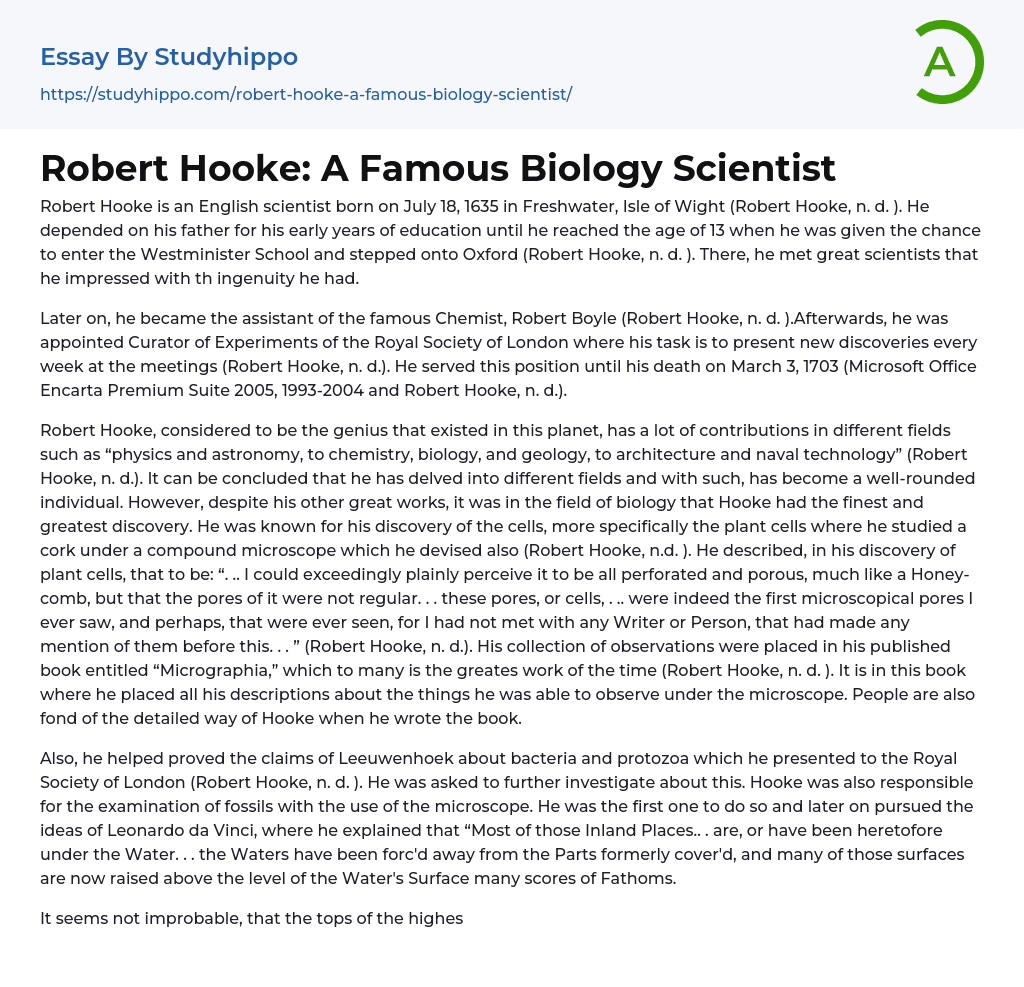Robert Hooke is an English scientist born on July 18, 1635 in Freshwater, Isle of Wight (Robert Hooke, n. d. ). He depended on his father for his early years of education until he reached the age of 13 when he was given the chance to enter the Westminister School and stepped onto Oxford (Robert Hooke, n. d. ). There, he met great scientists that he impressed with th ingenuity he had.
Later on, he became the assistant of the famous Chemist, Robert Boyle (Robert Hooke, n. d. ).Afterwards, he was appointed Curator of Experiments of the Royal Society of London where his task is to present new discoveries every week at the meetings (Robert Hooke, n. d.). He served this position until his death on March 3, 1703 (Microsoft Office Encarta Premium Suite 2005, 1993-2004 and Robert Hooke, n. d.).
R
...obert Hooke, considered to be the genius that existed in this planet, has a lot of contributions in different fields such as “physics and astronomy, to chemistry, biology, and geology, to architecture and naval technology” (Robert Hooke, n. d.). It can be concluded that he has delved into different fields and with such, has become a well-rounded individual. However, despite his other great works, it was in the field of biology that Hooke had the finest and greatest discovery. He was known for his discovery of the cells, more specifically the plant cells where he studied a cork under a compound microscope which he devised also (Robert Hooke, n.d. ). He described, in his discovery of plant cells, that to be: “. .. I could exceedingly plainly perceive it to be all perforated and porous, muc
like a Honey-comb, but that the pores of it were not regular. . . these pores, or cells, . .. were indeed the first microscopical pores I ever saw, and perhaps, that were ever seen, for I had not met with any Writer or Person, that had made any mention of them before this. . . ” (Robert Hooke, n. d.). His collection of observations were placed in his published book entitled “Micrographia,” which to many is the greates work of the time (Robert Hooke, n. d. ). It is in this book where he placed all his descriptions about the things he was able to observe under the microscope. People are also fond of the detailed way of Hooke when he wrote the book.
Also, he helped proved the claims of Leeuwenhoek about bacteria and protozoa which he presented to the Royal Society of London (Robert Hooke, n. d. ). He was asked to further investigate about this. Hooke was also responsible for the examination of fossils with the use of the microscope. He was the first one to do so and later on pursued the ideas of Leonardo da Vinci, where he explained that “Most of those Inland Places.. . are, or have been heretofore under the Water. . . the Waters have been forc'd away from the Parts formerly cover'd, and many of those surfaces are now raised above the level of the Water's Surface many scores of Fathoms.
It seems not improbable, that the tops of the highest and most considerable Mountains in the World have been under Water, and that they themselves most probably seem to have been the Effects of some
very great Earthquake” (Robert Hooke, n. d. ). Also, because of his versatility, he also designed a lot of buildings after the Great Fire of London in 1666 (Microsoft Office Encarta Premium Suite 2005, 1993-2004). Among these buildings are the Montague House and the Bethlehem Hospital. Little is known about Hooke and even a picture of him is hard to find.
This is attributed to the ill feelings of his colleague Isaac Newton, who formulated the law of gravity with the help of Hooke, who was not just able to grasp the mathematical formulation of which (Microsoft Office Encarta Premium Suite 2005, 1993-2004 and Robert Hooke, n. d. ). This is unfortunate for such a great master in the field of biology since a person could only be remembered through, aside from his works, a picture or a replica of him.
However, it suffices that his existence is proved by the fact that he left us with a lot of discoveries that helped a lot in the understanding of the world.
- Microbiology essays
- Bacteria essays
- Cell essays
- Enzyme essays
- Photosynthesis essays
- Plant essays
- Natural Selection essays
- Protein essays
- Viruses essays
- Cell Membrane essays
- Human essays
- Stem Cell essays
- Breeding essays
- Biotechnology essays
- Cystic Fibrosis essays
- Tree essays
- Seed essays
- Coronavirus essays
- Zika Virus essays
- Organic Chemistry essays
- Acid essays
- Calcium essays
- Chemical Bond essays
- Chemical Reaction essays
- Chromatography essays
- Ethanol essays
- Hydrogen essays
- Periodic Table essays
- Titration essays
- Chemical reactions essays
- Osmosis essays
- Carbohydrate essays
- Carbon essays
- Ph essays
- Diffusion essays
- Copper essays
- Salt essays
- Concentration essays
- Sodium essays
- Distillation essays
- Amylase essays
- Magnesium essays
- Acid Rain essays
- Agriculture essays
- Albert einstein essays
- Animals essays
- Archaeology essays
- Bear essays
- Biology essays
- Birds essays




